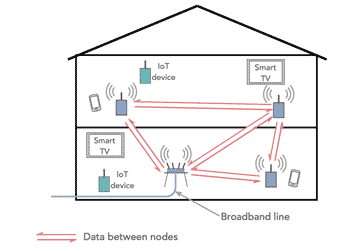What is a Wi-Fi Mesh Network
Wi-Fi mesh networks are advertised widely as being able to provide continuous Wi-Fi coverage within a home of office, but what are they are do they live up to their expectations.
WiFi IEEE 802.11 Includes:
Wi-Fi IEEE 802.11 introduction
Standards
Wi-Fi Alliance generations
Security
How to stay safe on public Wi-Fi
Wi-Fi Bands
Router location & coverage
How to get best Wi-Fi performance
How to buy the best Wi-Fi router
Wi-Fi boosters, range extenders & repeaters
Wi-Fi mesh network
Wi-Fi wired & powerline extender
Buy Wi-Fi equipment
Key Wi-Fi standards / variants:
802.11n
802.11ac
802.11ax Wi-Fi 6
802.11be Wi-Fi 7
Details of other standards variants
There is a lot of talk about Wi-Fi mesh networks, what they are and how they can fulfil the requirements for a wireless LAN in the home or office and eliminating dead-spots where no signal is present.
While it is possible to use Wi-Fi extenders, repeaters and boosters, a Wi-Fi mesh network will be able to give the best performance, enabling the Wi-Fi signal to reach all the places where it is needed.
Wi-Fi mesh networks are more expensive when compared to buying a Wi-Fi extender, booster, etc, but the performance should be better and warrant paying the additional cost.

Wi-Fi mesh network basics
There is often a lot of tech-speak from people about different technologies and the term mesh network is widely used, often incorrectly.
Accordingly it is worth trying to define exactly what a mesh network is and how it differs from other forms of Wi-Fi network.
Wi-Fi Mesh Network Definition:
A Wi-Fi mesh network is a group of Wi-Fi devices that all act as a single Wi-Fi network. Within the network there will be multiple Wi-Fi signal sources around the coverage area, instead of just a single router and in this way good coverage can be obtained where it is needed and dead-spots can be removed. The additional Wi-Fi sources are called nodes or sometimes points when referring to a mesh network.
The mesh network nodes are typically connected together wirelessly, although it is also equally possible to connected them using a wired link.
For the nodes to connect wirelessly, they must all be within range of another connected node in the network, otherwise they will not be able to communicate. However the network may choose to route the data as it sees best if there is more than one route from the man router to the node being accessed.
A wired connection can be convenient, and with more houses and offices being wired for Ethernet, this is an ideal solution, although an Ethernet switch may be required if the main access node cannot handle all the wired links. This is not an issue because it is very easy and cheap to install an Ethernet switch to accomplish this.

Some people may want to use a wired link that uses the house mains or power wiring. Schemes like Homeplug, etc can run data over these wires and recover it at the far end without the need for additional wiring.
These mesh networks normally come with software that helps with the set-up of the mesh network, enabling positioning to minimise the dead-spots while also ensuring that each node can effectively communicate with the main router either directly or indirectly.
Wi-Fi extenders vs mesh network
It may be thought that there is little difference between adding a Wi-Fi range extender, booster or repeater to a wireless local area network rather than opting for a more expensive Wi-Fi mesh network.
In fact there is a significant difference, and the installation of a mesh network may be a much better option for some situations, whereas the cost may not be viable for others. A choice will need to be made when looking at a Wi-Fi local area network, WLAN, and whether it is worth the investment in a more expensive mesh network or whether a single router with a repeater if required might be the more sensible option.
Wi-Fi mesh network:
A mesh network consists of a main router with one or more satellite nodes or "points."
The data communication between the main router and the node will be decided by the network to give the most effective link from the particular node being used to the main router. This may be direct, or via other nodes.
The outlying nodes do not all need to have a direct wireless link with the main router as other nodes or "points," making the deployment of a Wi-Fi mesh network relatively easy.
A Wi-Fi mesh network will normally be supplied with software to help set up the network more easily. The level of the software may may vary between different manufacturers and systems.
The mesh network will need to be bought from a single manufacturer, it is not normal to mix points from different manufacturers as they would not interface with each other.
The mesh network will appear as a single wireless network and there will be no need to re-log onto different networks as the mobile device moves from the coverage area of one WLAN point to that of another.
Wi-Fi with a repeater / extender:
A wireless LAN using a router and one of more secondary access points such as repeaters, boosters, etc. is rather different to a mesh network although there are some similarities.
Within a Wi-Fi LAN using a repeater, extender, etc, the remote node must be able to be in direct contact with the router. This makes positioning the repeater more critical, because if this is none wirelessly, the repeater, extender, etc must be able to provide coverage for the dead-spot as well as being able to communicate with the router.
While it is possible to use a wired connection, most people will want to achieve this wirelessly and this is more difficult than using a mesh network. It may also not be possible to cover some areas.
Any system using repeaters will tend to be made up from individual elements and these may be bought on an ad-hoc basis. This does give flexibility, but it may lead to other problems.
It is possible to assign the main router and the repeaters the same network name, but this will need to be configured manually, and many people may opt not to undertake this.
Points to check when selecting a mesh network
It can be difficult to be able to judge the best mesh network purely from the specifications. It can be even more difficult if you are not a mesh network tech wizard.

However there are a few points which can help with the selection and ensure the best chance of buying the right system is assured.
One of the first is to select a known brand. Yes it is possible that soem unknown brand may be able to offer a good deal, but the known brands have built a reputation and will want to ensure that this is maintained. As the quote from Benjamin Franklin says: "The bitterness of poor quality remains long after the sweetness of low price is forgotten."
As with any purchase, it is always best to check out the independent reviews as this will reveal a lot about the products and their suitability.
Also, all mesh network systems are slightly different. Although the basic concepts will be the same, the actual technology, specifications and the like will differ. As a result it is best to spend some time understanding the technology and seeing what works and what will work best for your situation.
Aspects including dual band and tri-band are worth investigating. As the inter-node links can limit bandwidth and hence the data transfer rates, it is worth looking at what will perform best.
It is also worth taking a look at the Wi-Fi mesh network management and set-up software. Good software will enable the best chance of setting up the system most effectively, so it is worth taking a good look at this.
Benefits of using a mesh network
It is worth summarising the benefits of using a mesh network over other forms of wireless LAN.
Wi-Fi mesh networks, are typically more expensive when compared to a wireless LAN made from a main router and repeaters, etc.
- Flexible coverage: Additional nodes can be added to get better coverage in hard-to-cover areas like hallways and near walls for outdoor coverage.
- Self healing: In a mesh network, if one node goes down, communication is simply rerouted through another node, assuming a link can be established.
- Direct path: Since all of the nodes are connected to each other, data can take several paths to reach the destination and the network will always select the best route from Point A to Point B.
Speed: Mesh WiFi is typically faster and more efficient at delivering a Wi-Fi signal than a range extender, so an improved level of performance is gained.
There are several very good Wi-Fi mesh network systems available now. They are becoming increasingly useful because it is necessary to have good Wi-Fi around the home, not only for the the obvious items like laptops, phones, smart TVs, game-boxes and the like, but also for the increasing number of connected devices that are around the home. As a result, having a good Wi-Fi signal around the home or office is increasingly important.
 Written by Ian Poole .
Written by Ian Poole .
Experienced electronics engineer and author.
Wireless & Wired Connectivity Topics:
Mobile Communications basics
2G GSM
3G UMTS
4G LTE
5G
Wi-Fi
Bluetooth
IEEE 802.15.4
DECT cordless phones
Networking fundamentals
What is the Cloud
Ethernet
Serial data
USB
LoRa
VoIP
SDN
NFV
SD-WAN
Return to Wireless & Wired Connectivity


